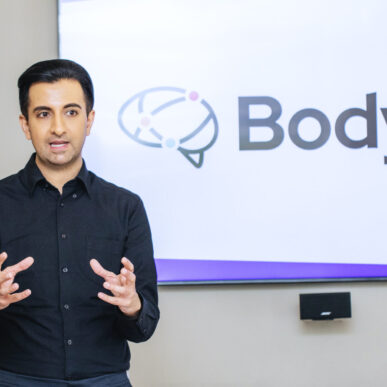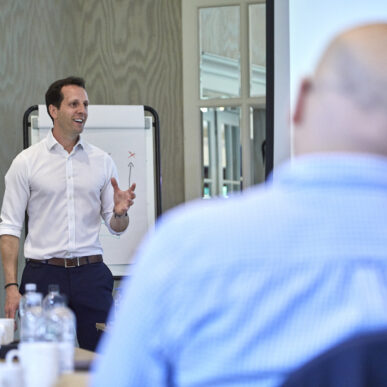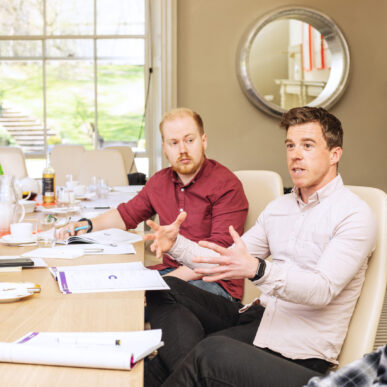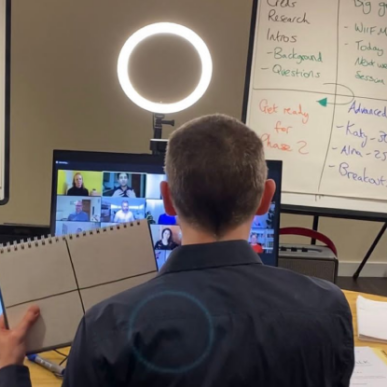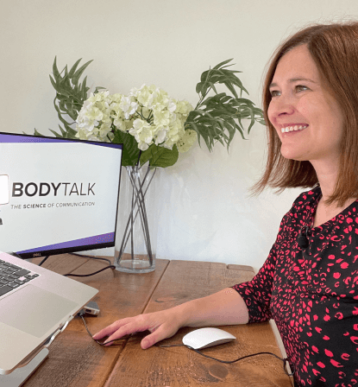A common phrase we often hear from people when they are preparing for a big speech or a meeting is ‘I’m not a natural presenter’.
If you feel nervous speaking, you’re not alone. One study has shown that 77% of people experience some anxiety about public speaking, also known as “glossophobia”.
It’s easy to think presenting is a gift that a lucky few are born with. The truth is that even for the most talented public speakers, most of their skill in presenting comes from practice. The best presenters put in enormous amounts of work behind the scenes to achieve real presence and gravitas on stage.
You can improve your own presentation skills from home. Here are fifteen tips that you can start practising right now to improve your presentation skills and make you look and feel much more confident on stage.
1. Use good body language to present confidently
One of the quickest ways to improve your impact as a presenter is to stand well.
At Body Talk, we created one of the most extensive academic studies on communication and influence. We discovered that a simple change in posture could increase your audience’s trust in you as a speaker by 42%.
Stand with your feet shoulder-width apart to present yourself as a confident speaker. It’s is a strong stance in which gravity works with your body, helping you stay grounded and confident.
Resist the temptation to sway from side to side, rock back and forth or pace around the stage, which can happen when you’re nervous. These movements come from our’ fight or flight response’, but for your audience, it’s distracting. Instead, try to achieve ‘dynamic stillness‘.
Dynamic stillness is the method of standing in one place while you speak powerfully. When you stand still and grounded, people pay more attention to you. If you’re not moving, your audience can concentrate much more on your message.
You can practice this at home. When you’re rehearsing your presentation, stand on a piece of paper or sheet of baking foil. If you hear rustling, then you’re moving around too much! Do this every time you practice until your muscle memory helps you achieve a strong, confident stance, every time.
2. Vary your pitch and pace
Vocal variety is always a great way to keep your audience engaged. When you’re speaking, don’t just rely on the same tone of voice for every sentence – vary it! It helps an audience understand how to feel about the information you’re giving them and makes it more engaging.
Two techniques you can practice are varying your pitch and pace to communicate your message. Use a higher pitch and faster speaking pace to excite or motivate your audience. Use a lower pitch and slower pace if you have something more serious or important to say. If you have a crucial point to make, consider pausing before you say it so the audience sits up and pays close attention.
When you’re nervous, there’s a tendency to speak at a higher pitch and speed up your speech, hoping you’ll get to the end quicker – but this shows the audience that you’re feeling nervous. Slowing down will make you appear calmer and more confident, and it will also give you time to think about what you’re going to say next.
Practice delivering your presentation aloud and use a watch or mobile phone to time yourself so that you’re not going too fast. Get used to the sound of your voice, and you’ll soon become much more comfortable speaking to any audience.
3. Add pauses to increase impact
As well as varying your pitch and pace, you can improve your presentation skills by adding pauses.
A well-timed pause is like throwing a spotlight on your key information – it makes people sit up and pay attention. So when you have something really important to say, think about adding a pause in before or after it. If you’re using a script or notes, you can even write the word ‘pause’ to help you to remember it.
Pausing is also a useful device for your audience, as it allows people to mentally process what you’ve been saying. This is especially important if people are writing down information as you’re speaking. Give them time to catch up, and don’t be afraid of the silence: simply clasp your hands together and wait a few seconds before continuing. You’ll look cool, calm and collected.
4. Avoid filler words
Filler words are those umms, erms and ahhs that creep into our presentations. They can happen when we’re nervous, unprepared or when we talk too quickly. Essentially, it’s like our mouth hasn’t quite caught up with our mind, but we make a sound to let the audience know that we haven’t finished speaking, and that another thought is coming.
Unfortunately, filler words can negatively impact our impact and gravitas. If you find that you use them a lot, firstly try to work out what’s causing them: do you need to slow down your pace? Do you know your content inside out? Are you so nervous that you can’t get the words out?
Pausing (see above) and breathing can help to eliminate filler words: instead of making a noise, just say nothing. It may feel like a long time for you to stand (or sit) in silence, but your audience won’t notice. Instead, you will appear in control.
5. Make eye contact
Another way to improve your presentation skills is to ensure you’re making eye contact with the audience. When we’re nervous, it can be tempting to read from our notes, or to read with our faces turned towards the slide that we’re presenting. This isn’t a great experience for your audience.
If you want to come across as a good presenter, ensure you’re looking directly at the people you’re speaking to. You only need to hold someone’s gaze for 1-2 seconds: any longer than that and it can start to feel uncomfortable for all involved. The rule of thumb with eye contact is to make it, then break it.
Eye contact is perhaps even more important when you’re working virtually. Ensure that you look into the lens of your webcam regularly: this will give your audience the impression that you’re genuinely making eye contact with them, which is better for trust and engagement.
6. Structure your presentation using storytelling
A powerful way to elevate your presentation skills is to structure your talk in a way that captivates and connects. A good starting point is to think about what your audience needs to hear, not what you want to say. Align your insights with their challenges and aspirations.
Storytelling plays a crucial role here. Rather than presenting dry facts or lengthy explanations, weave your information into concise, compelling stories. Think about creating a story arc that mirrors your audience’s journey. Begin by tapping into a relatable struggle, challenge, or question they face (the “pain point”) and then guide them towards a better future. This structure not only builds engagement but also makes the information resonate on a personal level, increasing the likelihood that your clients, colleagues, or stakeholders will not only remember but buy into your message.
Adding storytelling to your presentation also taps into the science of engagement. Studies show that stories activate more regions of the brain, helping people relate on an emotional level and retain information longer.
7. Create curiosity
Rhetorical questions are a powerful tool to spark curiosity and get your audience thinking deeply about your message. A well-placed question can shift your audience from passive listeners to active thinkers by prompting them to reflect on what you’re saying. For example, if you’re discussing a change that requires buy-in, you might ask, “What would it mean for you if this project succeeded beyond our expectations?” or “How would this change impact your day-to-day work?”
These questions don’t necessarily need answers but serve as mental prompts that help your audience internalise your message and make it personally relevant. Using questions throughout your presentation also breaks up your points, encouraging listeners to engage and reflect before you move forward.
8. Don’t use slides as your script
Reading word for word from slides or bullet points is incredibly dull to listen to and a sure-fire way for your audience to switch off.
Instead, change your relationship with how you use slide decks. Slides should be a visual aid to help your audience to understand your message. Remove lines of bullet points or other superfluous text that you’re using as an aide-memoire and, instead, use strong, clear images. Your slides are not your script!
All major slide presentation programs have sections for ‘presenter notes’ – a place to write text that’s visible to the presenter but not the audience. Avoid copying and pasting your whole script here, as you may become too tempted to look down and read from your laptop rather than addressing the audience.
Alternatively, you can use a printed ‘trigger script’ to remind you of the key points of your presentation. Condense these onto one side of A4 paper that you can have in front of you for easy access. A quick glance down will soon help you to find your place again.
And here’s a top tip: write out your bullet points or trigger script by hand, rather than typing it. Studies show that writing notes by hand forces the brain to become more deeply engaged with the information, making you more likely to remember it!
9. Personalise Your Message
A strong presentation isn’t just about hitting the key points; it’s about how you move from one idea to the next. Great transitions keep your audience engaged and help them follow your logic effortlessly. Here are some ideas of transition phrases to help your presentation flow smoothly:
To Introduce a New Point:
- “Building on that idea…”
- “This brings us to…”
- “Let’s shift gears and explore…”
To Provide an Example:
- “For instance…”
- “To put this in perspective…”
- “Let’s look at a real-world example…”
To Compare or Contrast:
- “On the other hand…”
- “While this may be true, we also need to consider…”
- “In contrast…”
To Emphasise a Key Point:
- “What this means is…”
- “The key takeaway here is…”
- “If you remember only one thing, it should be…”
To Summarise or Conclude:
- “To wrap things up…”
- “So, to bring it all together…”
- “As we come to a close…”
12. Show your passion!
How many times have you listened to someone give a presentation and even they sound bored with the information they’re delivering?
If you’re sharing important information that you care about, make sure that your audience can see your passion. This means ensuring your facial expressions are congruent with your message. If you’re sharing positive news, smile! Use open, palms-up gestures to help to show people that you care about this information.
Also, don’t assume that business presentations mean that you have to be staid and purely factual. Emotive language helps to engage audiences much better than plain facts and figures. If you’re proud of the way people have been working, say it! If you’re excited about a future project, ensure you’re using words which show that. Your passion will rub off on your audience.
13. Visualise success
A final tip is to use visualisation techniques to help train your brain for success.
Muhammed Ali, the greatest heavyweight boxer of all time, coined the phrase ‘Future History’ to describe how he visualised his own success before boxing matches. As well as undertaking the intense physical training needed, he would also visualise every detail of how he would win that match, picturing it with complete conviction and belief in the outcome. By the time he stepped into the ring, he was physically and mentally prepared – and the results speak for themselves.
A positive mindset can transform your belief in yourself as a presenter. There are many different techniques that you can practice which can help you to feel more in control and radiate confidence and competence to your audience.
14. Practice, practice, practice
The easiest way to become more confident in your presentation skills is to get used to hearing yourself out loud, yet most people don’t do this.
Set aside time to practice your presentation – and do so repeatedly until you’re comfortable with it. Practising out loud is essential, as it will help you to identify any areas you’re less confident with, or words or phrases that you might be likely to stumble over. You can do it in front of a mirror, to a family member – some of our team members even practise speaking to their pets!
The more you practice, the better you’ll become.
15. Seek Constructive Feedback
Finally, seek feedback from a trusted colleague or coach who can provide an outside perspective on your strengths and areas for improvement. Video yourself during a practice session to observe your body language, eye contact, and pacing. Honest feedback helps pinpoint any distracting habits, like excessive filler words or unintentional movements, allowing you to refine your presentation style before the big day.
Improve your presentation skills
While these are all great tips to practice at home, working with a communication coach is the best way to develop into a confident and competent presenter. If you’re feeling self-conscious about giving presentations, we can help – so don’t hesitate to get in touch with our team today.







